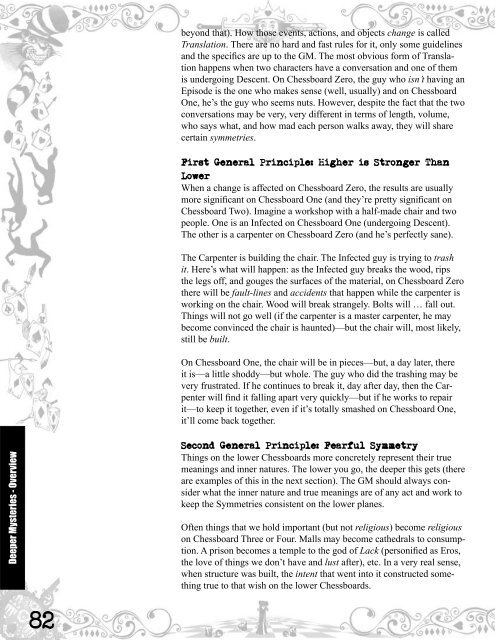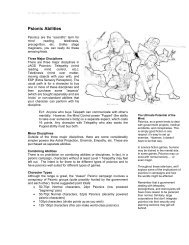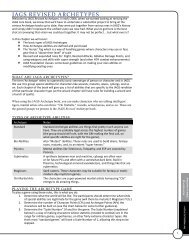Wonderland - Jags
Wonderland - Jags
Wonderland - Jags
You also want an ePaper? Increase the reach of your titles
YUMPU automatically turns print PDFs into web optimized ePapers that Google loves.
Deeper Mysteries - Overview<br />
82<br />
beyond that). How those events, actions, and objects change is called<br />
Translation. There are no hard and fast rules for it, only some guidelines<br />
and the specifics are up to the GM. The most obvious form of Translation<br />
happens when two characters have a conversation and one of them<br />
is undergoing Descent. On Chessboard Zero, the guy who isn’t having an<br />
Episode is the one who makes sense (well, usually) and on Chessboard<br />
One, he’s the guy who seems nuts. However, despite the fact that the two<br />
conversations may be very, very different in terms of length, volume,<br />
who says what, and how mad each person walks away, they will share<br />
certain symmetries.<br />
First General Principle: Higher is Stronger Than<br />
Lower<br />
When a change is affected on Chessboard Zero, the results are usually<br />
more significant on Chessboard One (and they’re pretty significant on<br />
Chessboard Two). Imagine a workshop with a half-made chair and two<br />
people. One is an Infected on Chessboard One (undergoing Descent).<br />
The other is a carpenter on Chessboard Zero (and he’s perfectly sane).<br />
The Carpenter is building the chair. The Infected guy is trying to trash<br />
it. Here’s what will happen: as the Infected guy breaks the wood, rips<br />
the legs off, and gouges the surfaces of the material, on Chessboard Zero<br />
there will be fault-lines and accidents that happen while the carpenter is<br />
working on the chair. Wood will break strangely. Bolts will … fall out.<br />
Things will not go well (if the carpenter is a master carpenter, he may<br />
become convinced the chair is haunted)—but the chair will, most likely,<br />
still be built.<br />
On Chessboard One, the chair will be in pieces—but, a day later, there<br />
it is—a little shoddy—but whole. The guy who did the trashing may be<br />
very frustrated. If he continues to break it, day after day, then the Carpenter<br />
will find it falling apart very quickly—but if he works to repair<br />
it—to keep it together, even if it’s totally smashed on Chessboard One,<br />
it’ll come back together.<br />
Second General Principle: Fearful Symmetry<br />
Things on the lower Chessboards more concretely represent their true<br />
meanings and inner natures. The lower you go, the deeper this gets (there<br />
are examples of this in the next section). The GM should always consider<br />
what the inner nature and true meanings are of any act and work to<br />
keep the Symmetries consistent on the lower planes.<br />
Often things that we hold important (but not religious) become religious<br />
on Chessboard Three or Four. Malls may become cathedrals to consumption.<br />
A prison becomes a temple to the god of Lack (personified as Eros,<br />
the love of things we don’t have and lust after), etc. In a very real sense,<br />
when structure was built, the intent that went into it constructed something<br />
true to that wish on the lower Chessboards.





